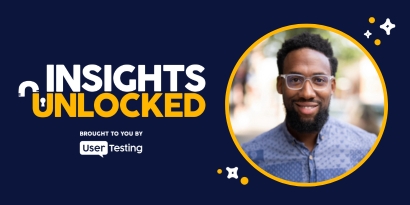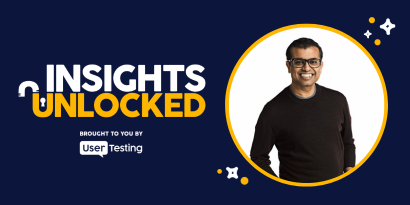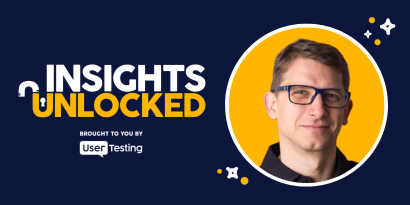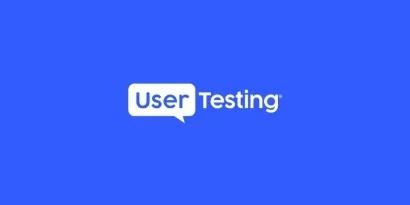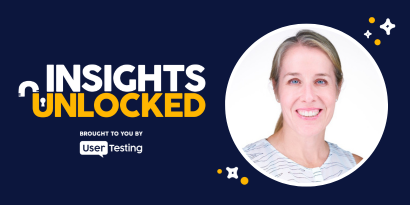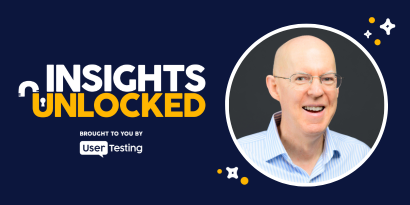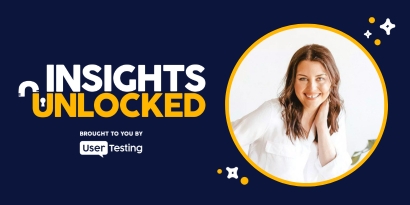
Episode 192 | October 13, 2025
Flipping the funnel starts with knowing your customers with Sangram Vajre
Discover why deep customer understanding—not more pipeline—is the key to GTM success, higher NRR, and smarter growth, with insights from Sangram Vajre.
Why NRR beats pipeline: Flipping the funnel starts with knowing your customers
You don’t need more pipeline. You need to understand your customers better.
That’s the message Sangram Vajre—co-founder of GTM Partners and creator of the Flip My Funnel movement—delivered during his appearance on Insights Unlocked. For years, Sangram has championed strategies like account-based marketing (ABM), go-to-market (GTM) alignment, and category design. But beneath all the frameworks and funnels lies a deceptively simple insight: your growth depends on how well you understand the people you serve.
“Everything I’ve ever worked on ties back to knowing your customer,” Sangram said. “You can't grow efficiently if you don't understand who you're trying to grow with.”
In this post, we’ll explore how customer insight powers better GTM execution, increases Net Revenue Retention (NRR), and helps companies move from transactional growth to meaningful market leadership.
The hidden cost of not knowing your customer
Every business claims to care about the customer. But most go-to-market strategies are built to serve internal metrics, not real people.
Sangram saw this firsthand as a co-founder of Terminus, where he helped popularize ABM by challenging traditional lead-based marketing models. His now-famous Flip My Funnel concept flipped the traditional funnel upside down—visually and strategically. Rather than chasing as many leads as possible, it focused on identifying high-fit accounts and building relationships from day one.
“The idea came from a napkin sketch on a flight,” Sangram recalled. “But what it really challenged was the mindset. Why are we wasting 99% of our marketing on people who will never buy?”
That question remains painfully relevant. According to Forrester, less than 1% of marketing-generated leads convert into customers. Sangram argues that this isn’t a sales failure or a marketing failure—it’s a customer understanding failure.
And the solution isn’t to push for 5X pipeline. It’s to step back and ask: Who are we actually trying to serve?
ON-DEMAND WEBINAR
Turning competitor feedback into your strategic edge
NRR: the most customer-centric metric in your GTM
If there's one metric Sangram believes should anchor your GTM strategy, it’s Net Revenue Retention (NRR). Unlike top-of-funnel KPIs, NRR forces companies to think about what happens after the sale—renewals, expansions, and the long-term value of customer relationships.
“If your NRR is above 120%, you can double your business in less than four years—without adding a single new customer,” he said. “That’s growth that comes from truly serving your existing customers.”
Here’s why NRR is so powerful:
It reflects whether your customers are finding ongoing value
It creates internal accountability across marketing, sales, product, and customer success
It uncovers whether your messaging aligns with the reality of your product
It exposes gaps in customer experience you might otherwise miss
In short, NRR doesn’t lie. It’s the clearest indicator of whether your company is aligned around delivering real outcomes—not just promises.
MOVE: a framework for GTM clarity
In his most recent book MOVE, Sangram introduces a four-part framework designed to help companies assess and improve their GTM strategy. MOVE stands for:
Market: Are you targeting the right customers?
Operations: Can you efficiently deliver value to them?
Velocity: How quickly can you grow?
Expansion: Where can you grow next?
The MOVE framework acts like a GTM MRI, exposing weaknesses across teams and functions. But at its core, it still centers on the customer.
“You can’t operate efficiently, grow fast, or expand confidently if you don’t understand your customer deeply,” Sangram noted. “MOVE forces you to ask questions most companies avoid.”
Those questions include:
Who are our best customers?
What signals predict success or churn?
Where do our best-fit accounts come from?
What are the friction points in their journey?
By asking—and answering—those questions, companies not only improve NRR, they also reduce their dependence on high pipeline coverage and drive more predictable growth.
ABM, GTM, and category creation all start with empathy
Although Sangram has moved on from the Flip My Funnel roadshow days, the philosophy behind it remains central to his work at GTM Partners. His mission now is to help B2B companies operationalize customer-first thinking at scale—especially as go-to-market models become more complex.
Much of what he teaches today through GTM University and his GTM Mondays newsletter boils down to one principle: empathy is a business advantage.
“The companies that win are the ones that get closer to their customers, faster,” he said. “That’s not a marketing tactic—it’s a growth strategy.”
That mindset has influenced everything from how companies run customer interviews to how they build roadmaps. And as Sangram pointed out, it's not just for marketers. Customer understanding must permeate:
- Product teams who need to know why users struggle
- Sales teams who need to qualify based on fit, not just interest
- Success teams who must recognize signals of churn or advocacy
- Executives who need to prioritize customer-led expansion over acquisition alone
When everyone is aligned around a shared understanding of the customer, growth stops feeling chaotic—and starts feeling intentional.
GUIDE
The executive's guide to empathy-driven ROI
AI and fractional leadership: scaling insight without scaling cost
As the GTM landscape evolves, Sangram also sees new opportunities in two key trends: AI-powered customer intelligence and fractional go-to-market leadership.
AI, he explains, allows companies to extract insights from behavior at scale—surfacing trends that would be impossible to see manually. Whether it's understanding feature adoption patterns, sentiment in open-ended survey responses, or usage gaps across segments, AI can help you make smarter decisions—faster.
“AI should eliminate 30-40% of the manual work you do, so you can focus on creativity, strategy, and customer connection,” he said. “That’s where humans add real value.”
At the same time, he sees many companies shifting toward fractional experts—senior marketers, revenue leaders, or customer strategists who come in part-time but bring deep experience and insight. Rather than hiring a full-time ABM lead to manage 5% of the strategy, companies are bringing in precise expertise where they need it most.
This model, he believes, aligns perfectly with a customer-first approach: more focus, less waste.
You can’t fake understanding
One of the most resonant parts of the interview was Sangram’s reflection on vanity metrics. He shared a story about a CMO who posted on LinkedIn celebrating a $50M pipeline contribution—only to be laid off a week later.
The reason? The pipeline wasn’t aligned with the company’s goals or strategy. It was big, but not useful.
“She told me, ‘It wasn’t the right pipeline. I didn’t really understand what mattered to the business,’” Sangram shared. “That’s not a tech problem. That’s a customer understanding problem.”
This story underscores a key point: you can’t fake understanding. You can automate emails, run ads, and hit arbitrary MQL numbers, but if you don’t know your customer—and align your GTM around that knowledge—it will catch up with you.
How to build a customer-intimate GTM engine
If you want to align your GTM strategy around true customer understanding, here are a few practical steps:
- Start with your best customers. Analyze what makes them successful—not just demographics, but behaviors, use cases, and outcomes.
- Use qualitative feedback tools. Platforms like UserTesting help you get inside the mind of your users and spot friction you’d never see in the data.
- Set NRR as a core KPI. Make it the heartbeat metric across sales, marketing, product, and success.
- Audit your messaging and segmentation. Are you attracting the right customers—or just the most clicks?
- Run cross-functional GTM diagnostics. Use frameworks like MOVE to identify misalignment and close gaps.
- Invest in insight, not just output. Whether through AI tools or fractional strategists, find ways to make customer understanding an everyday asset.
Final thoughts
Sangram’s journey—from Pardot to Salesforce to Terminus to GTM Partners—is a story of someone who’s constantly evolving, but always coming back to the same principle: deep customer understanding is the foundation of great go-to-market execution.
While Flip My Funnel may be in the past, its spirit lives on in every company that stops chasing volume and starts pursuing insight.
And as Sangram reminded us at the end of the episode:
“If you want to grow, don’t start with the funnel. Start with your customers. That’s where all the answers are.”
Episode links:
- Sangram Vajre on LinkedIn
- GTM Partners
- MOVE and other books
- GTM Mondays newsletter on Substack
- Nathan Isaacs on LinkedIn
- Turning customer insights into action — how to translate insights into better retention and business outcomes
- How to share customer insights throughout your organization — making insights visible and actionable across teams
- Add customer insights into your UX design process — embedding feedback into design & development workflows
- How human insight drives UX and business success (Jim Kalbach) — linking user research to business impact
- Conversion copywriting starts with customer research (Chris Silvestri) — using insights to refine messaging and optimize conversion
- The landing‑page lie: align channel expectations before the bounce happens — about aligning user expectations and messaging UserTesting
ON-DEMAND WEBINAR
The ROI of human insight: prove your value to upper management
Lorem ipsum dolor sit amet, consectetur adipiscing elit. Nunc vulputate libero et velit interdum, ac aliquet odio mattis.
